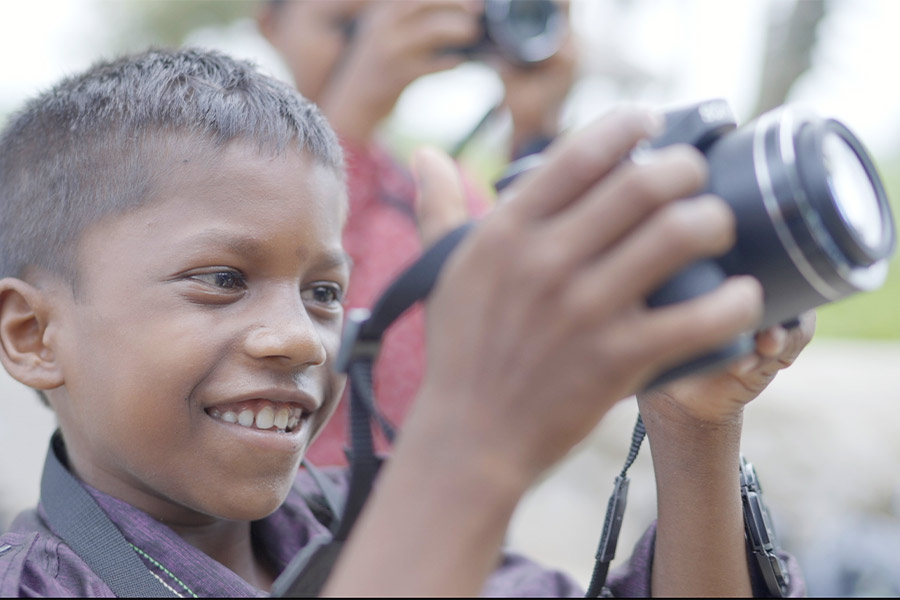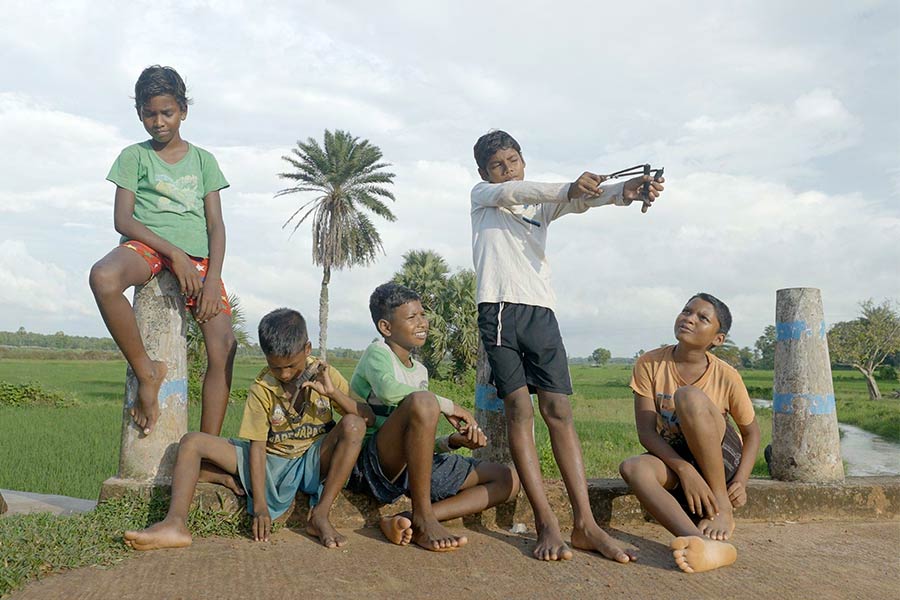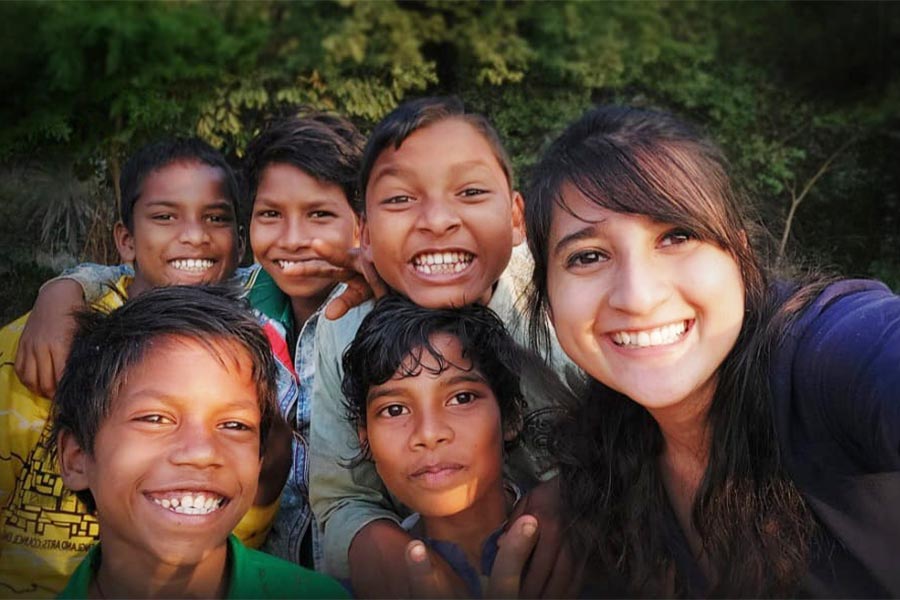No change is too small and nor is any changemaker. In Catapults to Cameras, the latest film directed and produced by Kolkata girl and Green Oscar winner Ashwika Kapur, the change is about altering the lens through which to view wildlife and the changemakers are five children, aged between nine and 13. Contextualising the rampant hunting festivals that take place in south Bengal (in spite of wildlife hunting being illegal in India), Catapults to Cameras revolves around Ashwika’s idea to replace the catapults habitually wielded by the five children with cameras and the consciousness around conservation it evokes.
Commissioned by Roundglass Sustain, Catapults to Cameras, which is an official selection at the London Bengali Film Festival in the UK this April, began “not as a documentary, but as an experiment”, according to Ashwika. Having learnt about the hunting festivals in 2019 through conservationists Suvrajyoti Chatterjee and Meghna Banerjee of HEAL, Ashwika could not believe her eyes when she first witnessed the brutality with which hoards of men would kill all kinds of animals at these festivals. “It wasn’t just about the big game. It was about [hunting] anything that moves. It was a blood sport, something they called phurti,” recalls Ashwika, who was particularly concerned by the engagement of young boys in such activities.
Hunting as a ‘rite of passage for masculinity’

On travelling to one of the villages near Jhargram, Ashwika discovered that “every house has weapons and every child has a catapult”
When Ashwika and Suvrajyoti went over to one of the villages (near Jhargram) involved in the hunting festivals, they understood how the hunting culture is baked into everyday life. “It’s a normal village in most ways, most of the villagers are farmers who aren’t dependent on the forests for livelihood. But every house has weapons and every child has a catapult,” narrates Ashwika.
“It’s not about ritualistic or traditional hunting. It’s almost like a rite of passage for masculinity” is how Samreen Farooqui, executive producer of the film, describes the hunting festivals. Her decision to commission the film stemmed from sensing the gravity of the situation and, in keeping with Roundglass Sustain’s motto, do work that “changes the way people look at India’s natural world”. “We want to move away from Western perspectives and offer our own language and our own prism. We want to find and amplify the Indian voice. For that, experimentation is important. As is disruption,” elaborates Samreen, who is still trying to convince Ashwika (over a video call with My Kolkata) that she could “smell a story” even though Ashwika only had a concept and not a script in mind when the film began.
“We wanted to make a good film, not a positive one,” clarifies Samreen, since neither she nor Ashwika had any clue of how the film would actually turn out in terms of a narrative. The five kids at the heart of the story — Raja, Ajoy, Tarash, Surajit and Lalu — could have responded to Ashwika’s proposal in any number of ways. As it turned out, they embraced the cameras and the difference in perspective that came with it. “What makes me proud about the film is its authenticity. As it is, you can’t direct children, so we didn’t try to contrive anything as filmmakers,” says Ashwika, who found the five kids with “contagious energy” on a bridge and convinced them to be a part of the film with support from two locals, Bappa and Bapi.
A heartwarming gesture offers the perfect resolution
As the film takes shape, one begins to view the wildlife on the screen through the eyes of the five protagonists. An intriguing interplay of curiosity, joy and humour defines the scenes where the youngsters look at animals as subjects, not as targets. Without saying too much, the five kids make it clear that they are having a gala time, be it documenting a snake being set free or shooting the rarest of birds from the rarest of angles. Ashwika’s voice-over provides context wherever necessary without imposing any opinions on the viewer.
A potential turning point arrives when an elephant makes its way into the village and is joined a few moments later by more of its kind, with the villagers gradually turning hostile. As darkness envelops the day, Ashwika is concerned by how the kids seem to be “enjoying the adrenaline of the conflict”. For a tense minute or two, it feels as if the week-long effort to transform the kids’ attitudes towards animals has gone in vain, that their compassion towards wildlife was only temporary.
“I was wondering if we had succeeded or not… Frankly, I didn’t have an ending in mind for the film. The closing interviews didn’t go as well as the opening ones. I don’t think the boys could adequately articulate how the whole thing had impacted them,” admits Ashwika, before her face lights up at how one of the boys, Ajoy, provided the most organic of resolutions to the film. As Ashwika and Suvrajyoti get into their car to go back to Kolkata, Ajoy hands his catapult to Ashwika, saying he does not need it anymore. An understated but powerful gesture validates the efforts of Ashwika and her team, who promise to return after a month with the images taken by the kids during their week-long photography sessions.
‘The film now has a life beyond the screen’

The five kids have turned mentors as part of the conservation project spawned by the film
Once Ashwika and Suvrajyoti make their way back to the village, the kids start chomping at the bit to see the fruits of their labour. They even organise a spontaneous pop-up exhibition of their photography, which attracts more villagers to the spot, resulting in greater awareness of the entire endeavour. During the final minutes of the film, one learns how one of the five boys, Raja, manages to convince his father to stop hunting and how Ashwika’s idea eventually paves the way for a full-fledged conservation initiative encompassing five villages, with the five kids stepping up as mentors.
“When HEAL started off with generating awareness [against wildlife hunting] in 2015-16, we didn’t think that the story would turn into cinema. But a mutli-faceted approach is paying dividends, be it from a legal, educational and now a cinematic standpoint. With the help of Roundglass Sustain, we’ve been able to replicate the original idea of Catapults to Cameras in other villages, and it’s safe to say that the carrot has prevailed over the stick in this respect,” observes Suvrajyoti. Samreen supplements Suvrajyoti by adding: “At Roundglass Sustain, we believe in the power of local stories as told by local people. I hope that this can now turn into a movement that spreads further and wider.”
What makes Catapults to Cameras refreshing is not just its premise but also its execution. Just like Ashwika and Suvrajyoti, the viewer is taken on a journey, unaware of the destination and unchained by the burdens of expectations. Unlike most wildlife documentaries, there is no aesthetic fetishisation of the wild and nor is there a plethora of facts and figures, which can often overpower the human story. The inherent innocence of the kids is not mined for sympathy. Rather, their sense of agency is brought out wherever relevant to show how they already have the capacity to think for themselves.
But the biggest success of Catapults to Cameras remains the fact that it is not just a documentary. As Ashwika says, “it now has a life beyond the screen”. The conservation project the film has spawned is a testament to how stories can create change, how children can be gamechangers.







